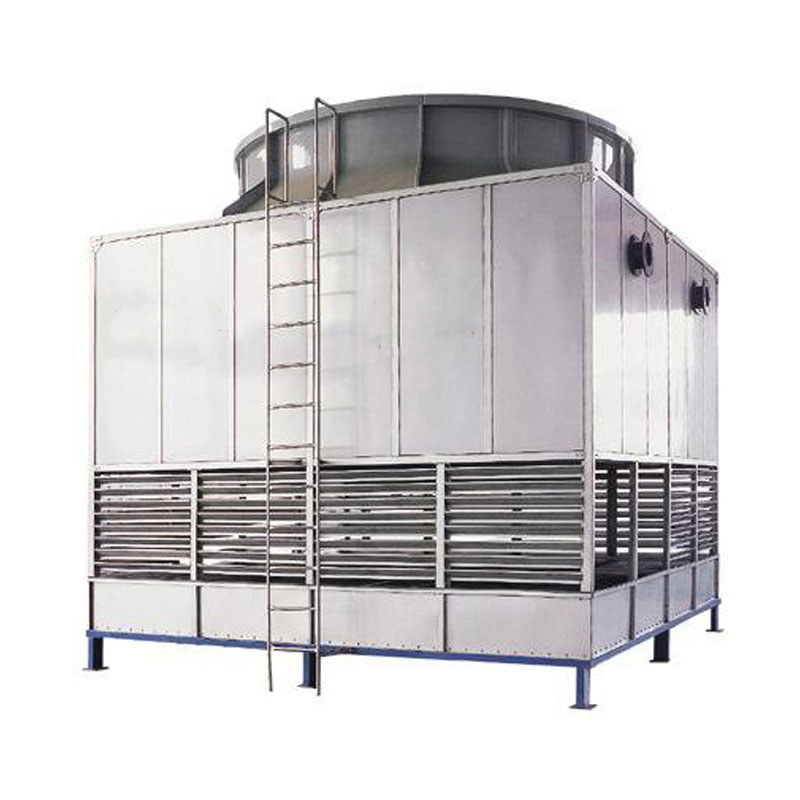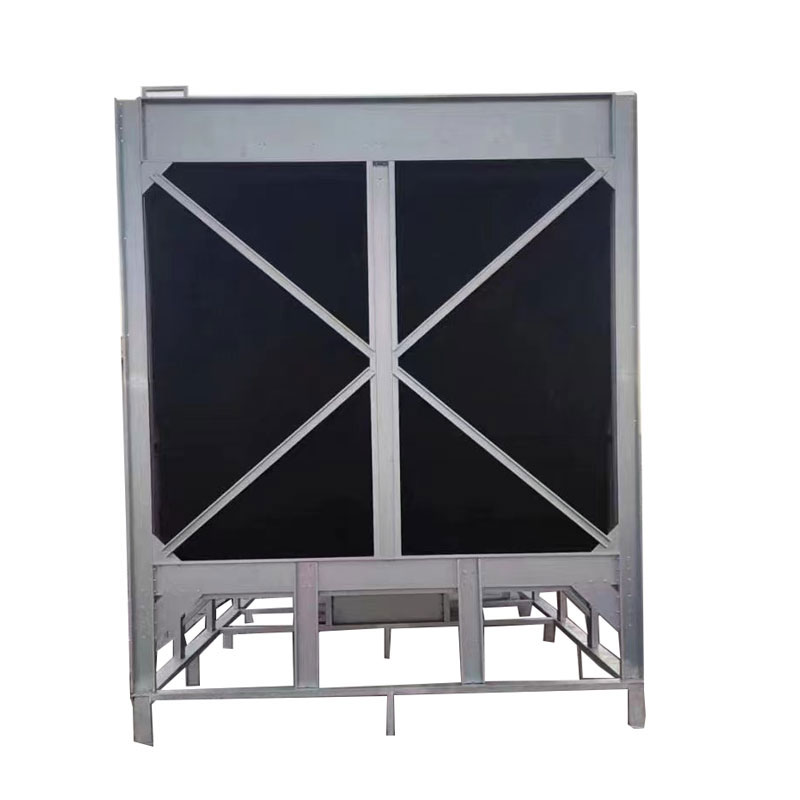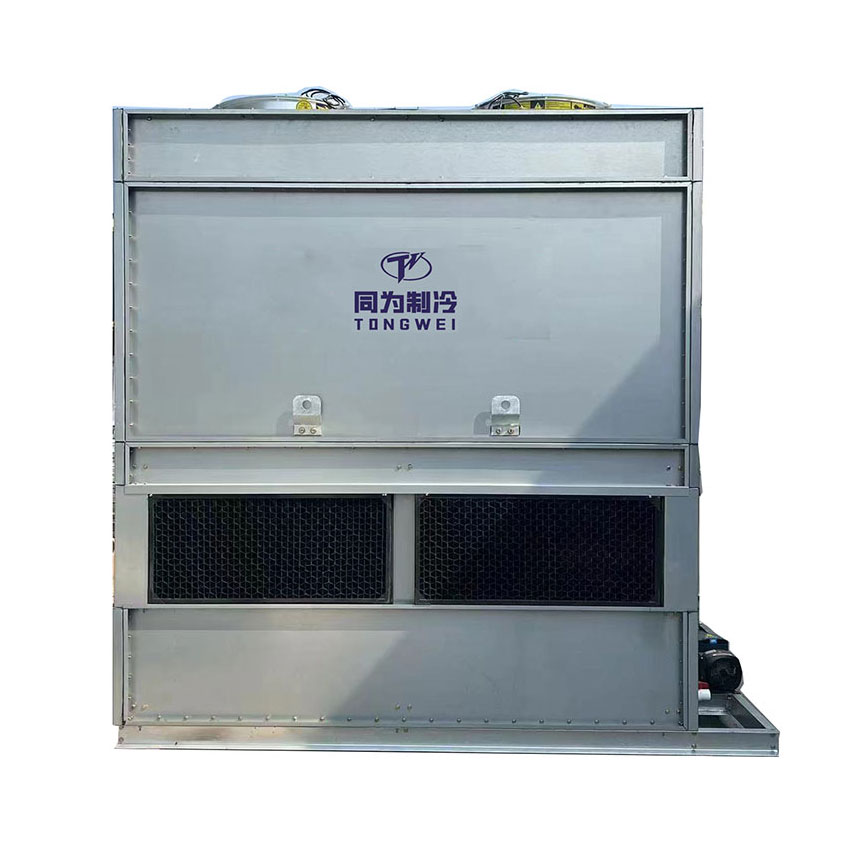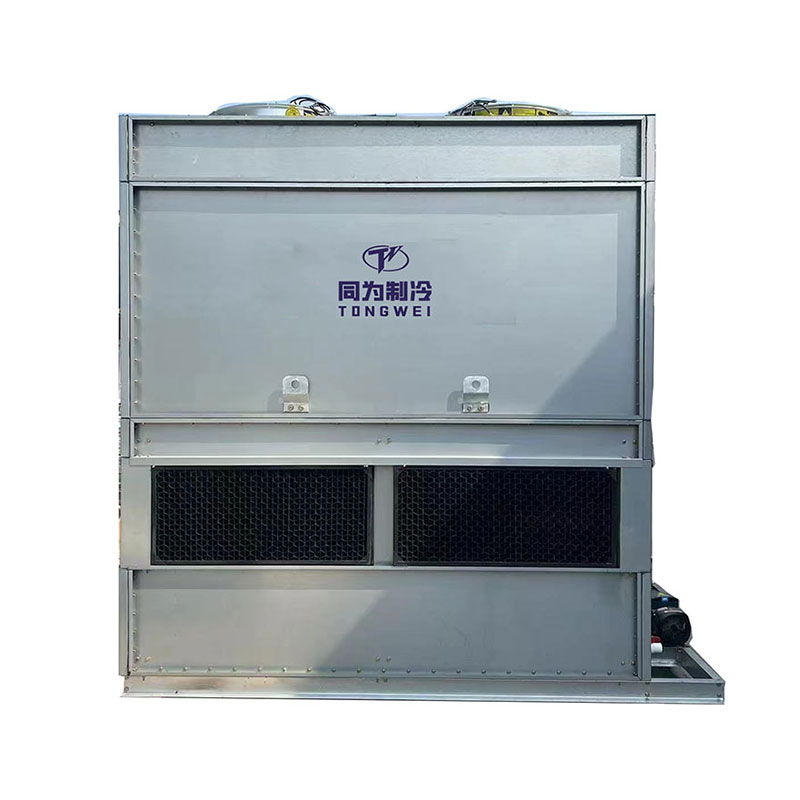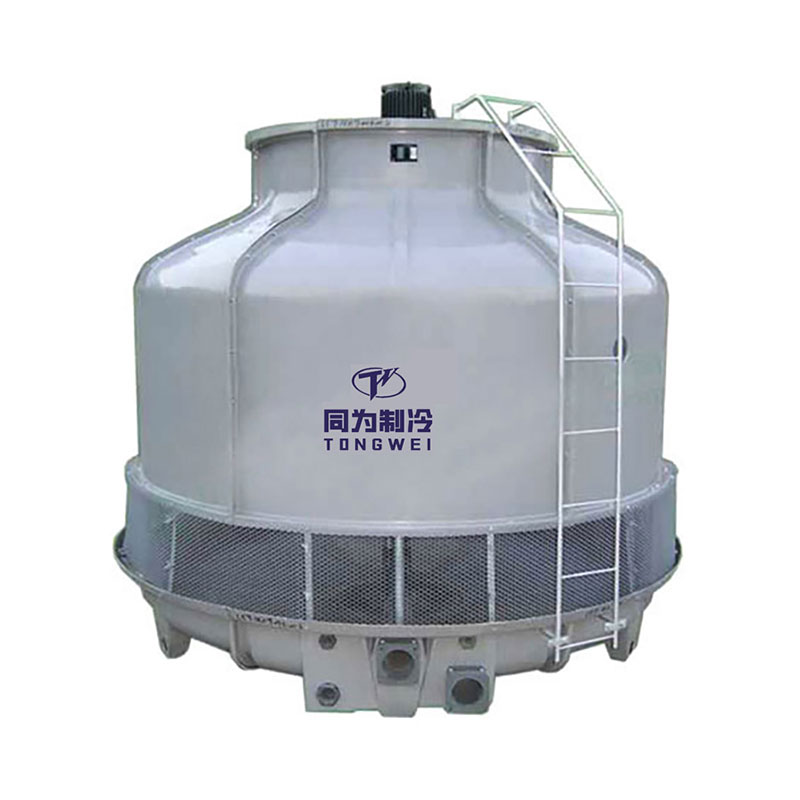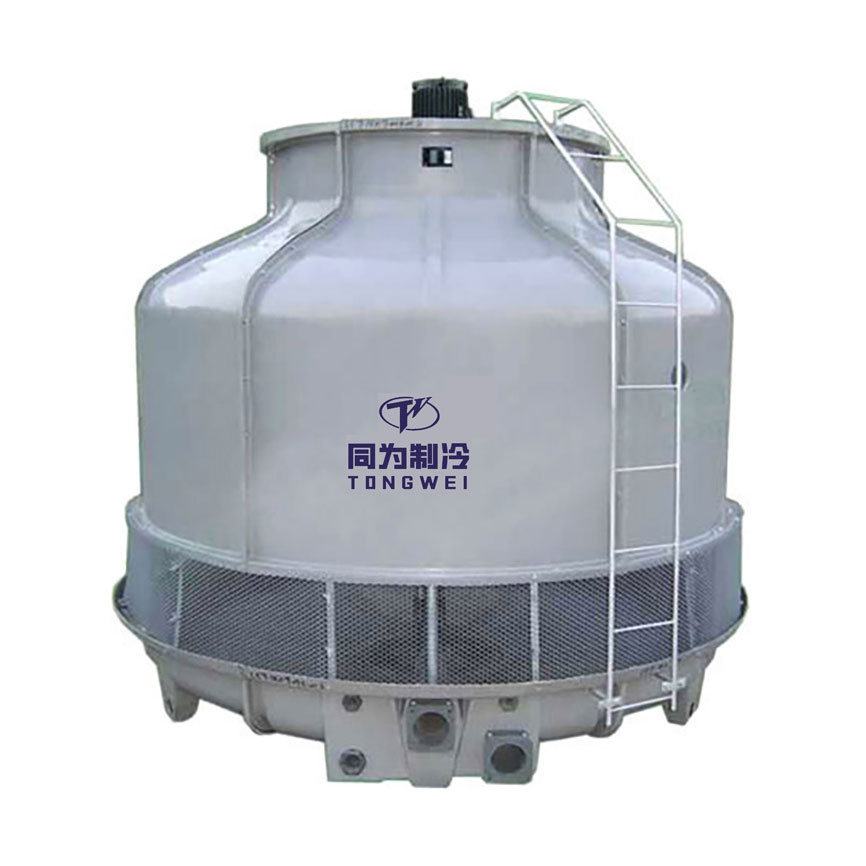Copyright © 2023 Guangdong Tongwei Machinery Co., Ltd. All Rights Reserved.
Links | Sitemap | RSS | XML | Privacy Policy200 Ton Square Type Water Cooling Tower
Send Inquiry
200 Ton Square Type Water Cooling Tower
What is A Water Cooling tower ?
A water cooling tower is a device that rejects waste heat to the atmosphere by cooling it to a lower temperature with a flow of coolant, usually water. A cooling tower can use the evaporation of water to remove process heat and cool the working fluid to near wet-bulb air temperature, or, in the case of a dry cooling tower, rely solely on air using a radiator to cool the working fluid to near dry-bulb air temperature.The cooling film adopts a curved twill design, which effectively extends the contact and heat exchange between the water circulation in the tower and the cooling air, making the air flow in the tower more reasonable and minimizing air resistance. At the same time, the fan adopts special-shaped blade design, which runs more smoothly, has lower noise and higher cooling efficiency. The cooling tower shell is made of high-quality high-strength fiberglass, which is not corroded by natural factors and chemical substances and remains fresh. All steel structures are hot-dip galvanized, which is anti-oxidation and anti-corrosion, making the tower more durable.
Common applications include the cooling of circulating water in refineries, petrochemical and other chemical plants, thermal power stations, nuclear power plants and HVAC systems used to cool buildings. Classification according to the type of air entering the tower: The main types of cooling towers are natural draft cooling towers and induced draft cooling towers.
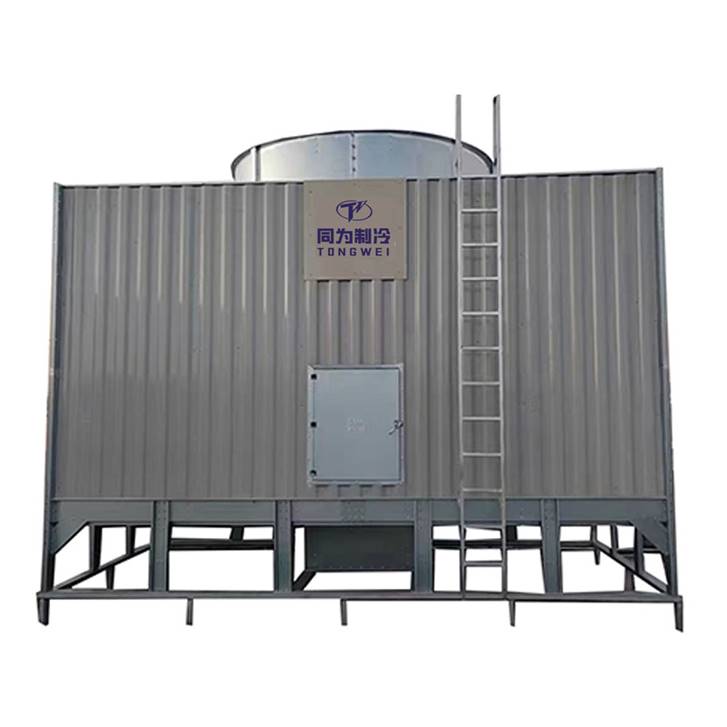
Square Type Water Cooling Tower
10 Ton To 1000 Ton Cooling Tower Technical Specifications
| 8 Ton ~150 Ton Cooling Tower Technical Specification | |||||||||||||||
| MODEL | Ton | TW | 8T | 10T | 15T | 20T | 25T | 30T | 40T | 50T | 60T | 80T | 100T | 125T | 150T |
| Data | Nominal Flow | m3/h | 6.23 | 7.81 | 11.7 | 15.6 | 19.5 | 23.4 | 31.2 | 39.2 | 46.8 | 62.6 | 78.1 | 97.6 | 117 |
| Air volume | CMM | 70 | 85 | 140 | 160 | 200 | 230 | 280 | 330 | 420 | 450 | 700 | 830 | 950 | |
| Motor | KW | 0.18 | 0.18 | 0.37 | 0.56 | 0.75 | 0.75 | 1.5 | 1.5 | 1.5 | 1.5 | 2.25 | 2.25 | 2.25 | |
| Noise Level | DBA | 45.5 | 47 | 48 | 50 | 52 | 54 | 56.5 | 57.5 | 58 | 59 | 60 | 60 | 60 | |
| Dry weight | KG | 42 | 46 | 54 | 67 | 98 | 116 | 130 | 190 | 240 | 260 | 500 | 540 | 580 | |
| Wet weight | KG | 180 | 190 | 290 | 300 | 500 | 530 | 550 | 975 | 1250 | 1280 | 1600 | 1640 | 1680 | |
| Piping | Water iniet | MM | 40 | 40 | 50 | 50 | 80 | 80 | 80 | 80 | 100 | 100 | 125 | 125 | 150 |
| Water outlet | MM | 40 | 40 | 50 | 50 | 80 | 80 | 80 | 80 | 100 | 100 | 125 | 125 | 150 | |
| Overflow | MM | 25 | 25 | 25 | 25 | 25 | 25 | 25 | 25 | 25 | 25 | 50 | 50 | 50 | |
| Drain | MM | 25 | 25 | 25 | 25 | 25 | 25 | 25 | 25 | 25 | 25 | 50 | 50 | 50 | |
| Flow Valve | MM | 15 | 15 | 15 | 15 | 15 | 15 | 15 | 15 | 20 | 20 | 20 | 20 | 20 | |
| Height | Tower Body | MM | 1700 | 1830 | 1645 | 1930 | 2150 | 1895 | 2040 | 2120 | 2345 | 2510 | 2690 | 2875 | 2875 |
| Casing | MM | 940 | 1070 | 855 | 1140 | 1385 | 1130 | 1255 | 1255 | 1290 | 1455 | 1595 | 1780 | 1780 | |
| Air inlet | MM | 170 | 170 | 170 | 170 | 245 | 245 | 245 | 245 | 325 | 325 | 325 | 325 | 325 | |
| Water Basin | MM | 420 | 420 | 450 | 450 | 450 | 340 | 340 | 420 | 460 | 460 | 450 | 450 | 450 | |
| Water iniet | MM | 270 | 270 | 280 | 175 | 175 | 175 | 175 | 230 | 295 | 295 | 300 | 300 | 300 | |
| Water Outlet | MM | 180 | 180 | 190 | 190 | 115 | 115 | 115 | 125 | 200 | 200 | 230 | 230 | 230 | |
| Foundation | MM | 250 | 250 | 250 | 250 | 300 | 300 | 300 | 300 | 300 | 300 | 300 | 300 | 300 | |
| Diameter | Exhaust Fan | MM | 550 | 635 | 635 | 770 | 770 | 930 | 930 | 930 | 1180 | 1180 | 1450 | 1450 | 1450 |
| Water Basin | MM | 920 | 920 | 1165 | 1165 | 1285 | 1650 | 1650 | 1880 | 2100 | 2100 | 2900 | 2900 | 2900 | |
| Foundation | MM | 554 | 554 | 797 | 797 | 1016 | 1016 | 1170 | 1170 | 1600 | 1600 | 2495 | 2495 | 2495 | |
| Anchor Bolt | BD | 9x3 | 9x3 | 9x3 | 9x3 | 9x3 | 9x4 | 9x4 | 9x4 | 11x4 | 11x4 | 11x6 | 11x6 | 11x6 | |
| Material | Fan | Fiberglass reinforced plyyester/Aluminnum alloy | |||||||||||||
| Fan Guard | Galvanized steel | ||||||||||||||
| Motor | T.E.F.C. 220V-480V 50HZ/60HZ 3PH | ||||||||||||||
| Mo tor Support | |||||||||||||||
| Shell | ffiberglass reinforced polyester(F.R.P) | ||||||||||||||
| Water Basin | |||||||||||||||
| Sprinkler System | Falum.Alloy/PVC pipe | ||||||||||||||
| Eliminator | fiberglass reinforced polyester(F.R.P) | ||||||||||||||
| Tension Bar | galvanized steel | ||||||||||||||
| Airinlet Support | Eplastic steel/PVC pipe | ||||||||||||||
| Tower Support | galvanized steel | ||||||||||||||
| Ladder | |||||||||||||||
| Pipe | PVC pipe | ||||||||||||||
| In-fill Support | galvanized steel | ||||||||||||||
| In-fill | PVC Film | ||||||||||||||
| 175 Ton ~1000 Ton Cooling Tower Technical Specification | ||||||||||||||
| MODEL | Ton | TW | 175T | 200T | 225T | 250T | 300T | 350T | 400T | 500T | 600T | 700T | 800T | 1000T |
| Data | Nominal Flow | m3/h | 136.8 | 156.24 | 175.5 | 195.12 | 234 | 273.24 | 312.12 | 329.4 | 468 | 547.2 | 626.4 | 781.2 |
| Air volume | CMM | 1150 | 1250 | 1500 | 1750 | 2000 | 2200 | 2400 | 2600 | 3750 | 3750 | 5000 | 5400 | |
| Motor | KW | 3.75 | 3.75 | 5.5 | 5.5 | 7.5 | 7.5 | 11 | 15 | 15 | 18.5 | 22 | 22 | |
| Noise Level | DBA | 60 | 60 | 54 | 55 | 56 | 57 | 59 | 60 | 65 | 66 | 73 | 74 | |
| Dry weight | KG | 860 | 880 | 1050 | 1080 | 1760 | 1800 | 2840 | 2900 | 3950 | 4050 | 4700 | 4900 | |
| Wet weight | KG | 1960 | 1980 | 2770 | 2800 | 3930 | 3970 | 5740 | 5800 | 9350 | 9450 | 11900 | 12100 | |
| Piping | Water iniet | WI | 150 | 150 | 200 | 200 | 200 | 200 | 200 | 250 | 250 | 250 | 300 | 300 |
| Water outlet | WO | 150 | 150 | 200 | 200 | 200 | 200 | 200 | 250 | 250 | 250 | 300 | 300 | |
| Overflow | OF | 50 | 50 | 80 | 80 | 80 | 80 | 80 | 100 | 100 | 100 | 100 | 100 | |
| Drain | DR | 50 | 50 | 80 | 80 | 80 | 80 | 80 | 100 | 100 | 100 | 100 | 100 | |
| Flow Valve | FV | 25 | 25 | 40 | 40 | 40 | 40 | 40 | 50 | 50 | 50 | 80 | 80 | |
| Quick Supply | QV | 25 | 25 | 40 | 40 | 40 | 40 | 40 | 50 | 50 | 50 | 80 | 80 | |
| Height | Tower | TH | 3515 | 3515 | 4170 | 4170 | 4360 | 4360 | 4550 | 4550 | 5310 | 5510 | 5660 | 5860 |
| Motor | MH | 350 | 350 | 590 | 590 | 680 | 680 | 710 | 710 | 840 | 840 | 940 | 940 | |
| Casing | CH | 1965 | 1965 | 2060 | 2060 | 2160 | 2160 | 2180 | 2180 | 2430 | 2630 | 2680 | 2880 | |
| Air inlet | AH | 350 | 350 | 620 | 620 | 620 | 620 | 760 | 760 | 1020 | 1020 | 1020 | 1020 | |
| Water Basin | WH | 850 | 850 | 900 | 900 | 900 | 900 | 900 | 900 | 1020 | 1020 | 1020 | 1020 | |
| Water in/out | IH | 245 | 245 | 280 | 280 | 280 | 280 | 280 | 280 | 340 | 340 | 340 | 340 | |
| Foundation | FH | 300 | 300 | 300 | 300 | 300 | 300 | 400 | 400 | 400 | 400 | 400 | 400 | |
| DIA | Exhaust Fan | ED | 1750 | 1750 | 2135 | 2135 | 2440 | 2440 | 2745 | 2745 | 3400 | 3400 | 3700 | 3700 |
| Water Basin | WD | 3310 | 3310 | 4120 | 4120 | 4730 | 4730 | 5600 | 5600 | 6600 | 6600 | 7600 | 7600 | |
| Foundation | FD | 3400 | 3400 | 4300 | 4300 | 4920 | 4920 | 5760 | 5760 | 6760 | 6760 | 7500 | 7500 | |
| Anchor Bolt | BD | 16x8 | 16x8 | 16x12 | 16x12 | 16x12 | 16x12 | 16x24 | 16x24 | 25x32 | 25x32 | 25x32 | 25x32 | |
| Material | Fan | Fiberglass reinforced plyyester/Aluminnum alloy | ||||||||||||
| Fan Guard | Galvanized steel | |||||||||||||
| Motor | T.E.F.C. 220V-480V 50HZ/60HZ 3PH | |||||||||||||
| Mo tor Support | ||||||||||||||
| Shell | ffiberglass reinforced polyester(F.R.P) | |||||||||||||
| Water Basin | ||||||||||||||
| Sprinkler System | Falum.Alloy/PVC pipe | |||||||||||||
| Eliminator | fiberglass reinforced polyester(F.R.P) | |||||||||||||
| Tension Bar | galvanized steel | |||||||||||||
| Airinlet Support | Eplastic steel/PVC pipe | |||||||||||||
| Tower Support | galvanized steel | |||||||||||||
| Ladder | ||||||||||||||
| Pipe | PVC pipe | |||||||||||||
| In-fill Support | galvanized steel | |||||||||||||
| In-fill | PVC Film | |||||||||||||
Features and Advantages of Water Cooling Tower
» Our water cooling tower is with a compact design, high cooling efficiency, and takes up little installation space.
» More perfect cooling performance than ordinary cooling towers, less power consumption, saving you money.
» Fiberglass cooling towers have the advantages of corrosion resistance, high strength, light weight, small size, small footprint, beautiful appearance and durability, and convenient transportation, installation and maintenance.
» The glass fiber reinforced plastic cooling tower adopts counter-flow air heat exchange technology, and the filler uses high-quality modified perchlorethylene wave plates to diffuse the water spray area; by rotating the water distributor, the water distribution is evenly distributed and the cooling effect is improved.
» The cooling tower has a reasonable shape, stable air flow, excellent material, and bright color. The surface coating resin contains anti-UV agent, which is aging-resistant, high-strength, light-weight, and corrosion-resistant.
» Cooling tower filling membrane: using modified PVC corrugated plate with horizontal ribs, strong water weight distribution ability, low resistance, good thermal performance, high temperature resistance of 70 degrees, low temperature - 50 degrees, and good fire resistance.
As a professional cooling tower manufacturer for over 15 years, products of Tongwei are divided into a circular counter flow cooling tower, a square counter flow cooling tower, a square cross flow cooling tower and a large FRP cooling tower.
The cooling tower series products produced by our factory are corrosion-resistant, high strength, lightweight, small size, small footprint, beautiful and durable, and convenient for transportation, installation, and maintenance.
Therefore, our cooling tower is widely used in all sectors of industries, such as air conditioning, refrigeration, air compression station, heating furnace, condensation process, and other cooling water cycle systems.
What is The Purpose of A Water Cooling Tower?
A water cooling tower is used to cool water and is a giant heat exchanger that removes building heat to the atmosphere and returns cooler water to the cooler. Water cooling towers receive warm water from the chiller.
This warm water is called condenser water because it gains heat in the condenser of the chiller. The cooler is usually on a lower level, such as a basement. The purpose of the cooling tower is to cool the water so that it can return to the chiller to absorb more heat.
How Does a Water Cooling Tower Work?
Air conditioning equipment and industrial processes generate large amounts of hot water that need to be cooled. This is where industrial cooling towers come in. The superheated water passes through a cooling tower where it is recirculated and exposed to cool, dry air. Heat leaves the circulating cooling tower water through evaporation.
This is called evaporative cooling. The cooler water then re-enters the air conditioning unit or process to cool the unit, and the cooling cycle repeats over and over again. When the hot condenser enters the cooling tower, the water passes through some nozzles that spray the water into small droplets, which increases the surface area of the water and allows for better heat loss through greater evaporation.
The function of the fan at the top of the water-cooling tower is to bring in the air at the bottom of the tower and move it upward in the opposite direction to the warm condensation water at the top of the unit. The air will carry heat through the evaporation of water from the cooling tower into the atmosphere.
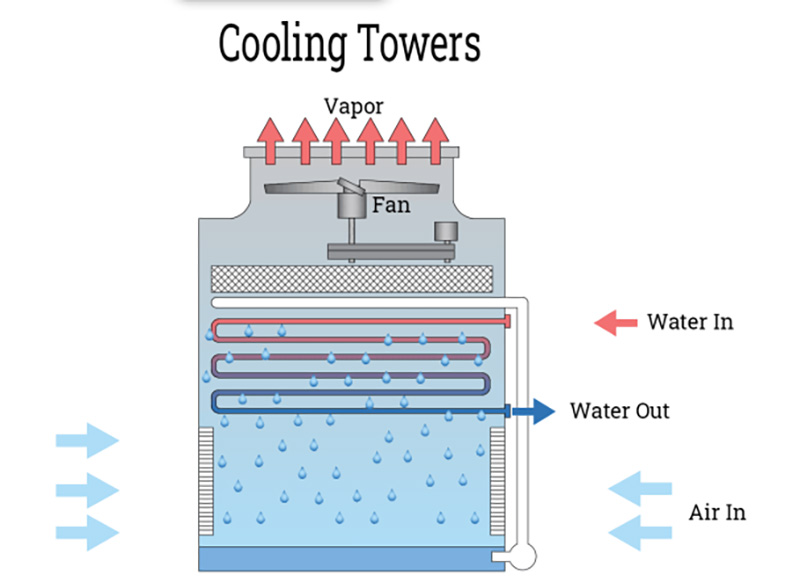
Why Does Need An Industrial Water Cooling Tower?
Industrial cooling towers are a key component of many refrigeration systems and can be found in industries such as power plants, chemical processing, steel mills, and many manufacturing companies that require process cooling. Additionally, commercial cooling towers can be used to provide comfort cooling to large commercial buildings such as airports, schools, hospitals, or hotels.
Industrial cooling towers can be larger than HVAC systems and are used to remove heat absorbed by circulating cooling water systems used in power plants, refineries, petrochemical plants, natural gas processing plants, food processing plants and other industrial facilities.
As the world‘s population has grown, the world‘s demand and requirements for manufactured goods have also grown tremendously. This forces the industrial sector to produce more and more products every day, thereby generating more manufacturing process heat.
Industrial machines and processes that generate large amounts of heat must be constantly cooled so that these machines can continue to operate efficiently. The most effective, efficient and cheapest solution to remove this heat is to install an industrial cooling tower.
Components of A Water Cooling Tower
The Frame and Casing: This is the tower’s structure, usually made of robust material like metal or fiberglass.
The Fill: This is where the action happens. The fill increases the contact area between the air and the water.
The Cold Water Basin: This collects the cooled water at the bottom of the tower, where it’s sent back to cool the industrial process.
The Drift Eliminators: These guys capture water droplets that could be carried away with the escaping air.
The Fans: They draw air through the tower, aiding the evaporation process.
Types of Water Cooling Towers
Not all towers are suitable for all applications. Water cooling towers are designed and manufactured in several types and are available in many sizes. When determining the right tower for a project, it is important to understand the various types and their advantages and limitations. Under certain water treatment conditions, the cooling effect is one of the important performances of the cooling tower. When selecting a water cooling tower, the main consideration is whether there are special requirements for cooling degree, cooling water volume, and wet bulb temperature. It is usually installed in a place with good ventilation.
According to the flow direction of hot water and air, there are cross-flow (AC) cooling towers and counter-flow cooling towers.
Crossflow Cooling Towers
In crossflow cooling towers the water flows vertically through the fill while the air flows horizontally, across the flow of the falling water.
It is commonly used in residential areas with strict noise requirements, and is the most commonly used cooling circulation tower in the air conditioning industry.
Energy saving, low water pressure, small wind resistance, low-speed motor, no dripping noise and wind noise, easy maintenance of filling and water distribution system.
It should be noted that the frame needs 40% more filler volume when exchanging heat. The filler is easy to age, the water distribution holes are easy to be blocked, the anti-icing is not good, and the moisture backflow is large. The advantages of cross-flow towers are exactly the disadvantages of counter-flow towers.
Counterflow Cooling Towers
Counterflow cooling towers are designed so that air flows vertically upward, opposing the flow of water descending through the fill.
Because of this vertical air flow, it is not possible to use the open gravity flow basins typical of cross-flow designs. In contrast, counterflow towers use a pressurized, pipe-type spray system to spray water onto the top of the packing.
Since air must be able to pass through the spray system, the distance between the ducts and nozzles must be further apart to avoid restricting airflow.
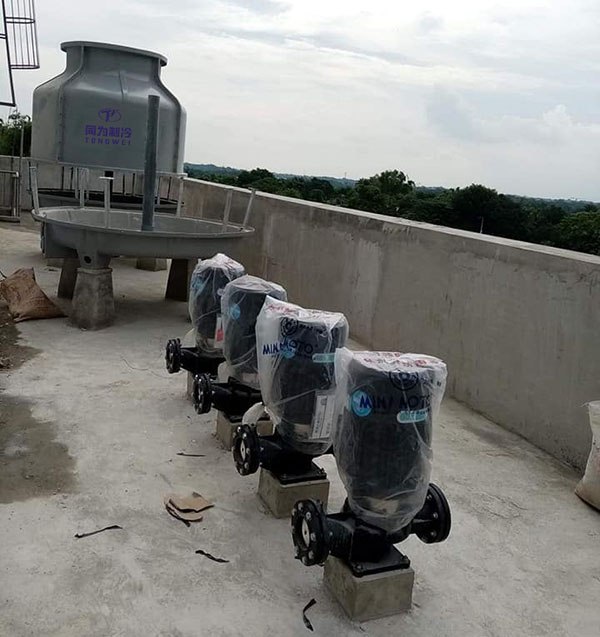
According to circulating water circuit, there are open type water cooling tower and closed type water cooling tower
Open Type Cooling Tower
By spraying circulating water onto the glass fiber filler, heat exchange is achieved through the contact between water and air, and then a fan drives the air flow in the tower to circulate, taking out the hot air flow after exchanging heat with the water, thereby achieving cool down.
Closed Type Cooling Tower
▷ The closed cooling tower has a fully closed circulation of cooling medium, which can prevent debris from entering the cooling pipeline system and evaporation loss of the cooling medium.
▷ Use soft water as the cooling medium, no scaling, no clogging of pipelines, and fewer failurs.
▷ Adopting dual cooling methods of air cooling and spray water evaporation and heat absorption, the cooling efficiency is high.
▷ The device is small in size, takes up little space, is easy to move and place, and does not require the construction of a pool.
▷ Using automated intelligent control, the cooling mode can be automatically changed according to working conditions, and the operation is simple and reliable.
▷ It has a wide range of uses and can directly cool quenching liquid, oil, alcohol and other media that have no corrosive effect on the heat exchanger. The medium has no loss and has stable composition.
Cooling Tower Efficiency and Maintenance
Proper maintenance is key to optimizing cooling tower efficiency and extending cooling tower life. This includes routine inspections, repairs and preventive measures to detect and resolve potential problems early. Here is an overview of the various steps involved in cooling tower maintenance.
Regular cleaning
Keeping your cooling tower clean is critical to its optimal operation. This includes cleaning the pool to remove any sediment and prevent algae growth, which can block water flow and reduce cooling efficiency. Additionally, the filling media within the tower should be kept clean to ensure maximum air-water contact.
Water treatment
The quality of cooling tower water directly affects the performance of the cooling tower. Regular water treatment, including the use of biocides, algicides, and antiscalants, can prevent problems such as corrosion, scaling, and biological growth that can damage cooling towers and reduce their efficiency.
Mechanical component inspection
The mechanical parts of the cooling tower, such as fans, motors, belts, etc., need to be checked regularly for signs of wear. Prompt replacement or repair of these components can prevent failures and maintain tower performance.
Monitor cooling tower performance
Regular performance monitoring is critical to ensuring your cooling tower is operating as efficiently as possible. This includes tracking key parameters such as water flow rate, air flow rate and cooling capacity. Any significant changes in these parameters may indicate a problem that requires immediate attention.
Seasonal preparations
Because cooling towers are exposed to the elements, they need to be prepared for different seasons. For example, it is crucial to properly winterize cooling towers before winter sets in. Instead, preparing for summer involves ensuring cooling towers can handle the higher loads associated with warmer weather.
Shipping Way of Cooling Tower
As a professional water cooling tower supplier &exporter,we have our own shipment forwarder to arrange the shipment .And the cooling tower is with big volume,so generally customers will choose the delivery by sea , if customer choose LCL by sea, we will pack the cooling tower with Plywood box ;if customer choose FCL by sea ,we just load the cooling tower into the container .
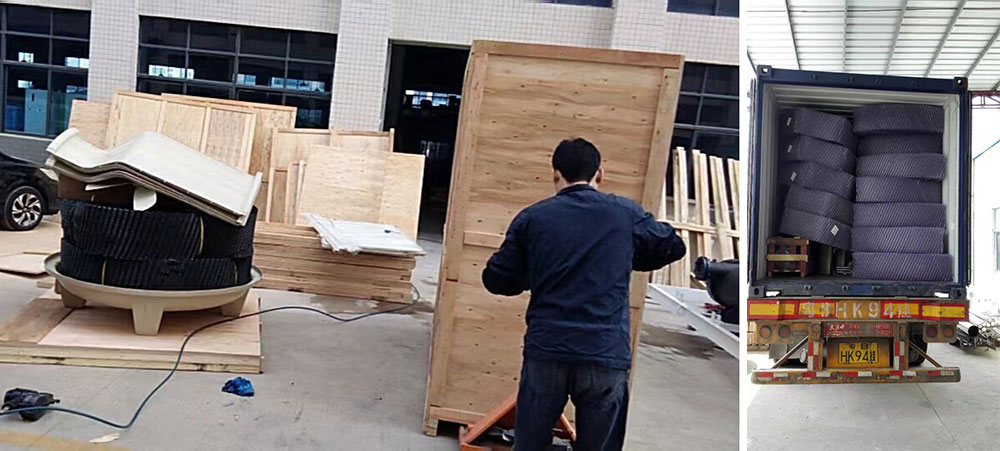
Why should you choose Tongwei for your cooling tower supplier?
▪ Experience you can trust
We have been designing and building water chiller and cooling tower for over 15 years. From chiller to water cooling tower and everything in between, we have built chillers for nearly every industry and every application.
▪ Fast Quote
Get a quote for your project today! We typically provide a custom quote within 2 hours.
▪ 24/7 customer service
Believe that we will always be by your side. Whether you have a question or need a quote, there‘s always someone answering the phone 24 hours a day.
▪ Durable and reliable machine
Our products are manufactured from high quality materials and we offer a competitive warranty on all industrial cooling tower.



